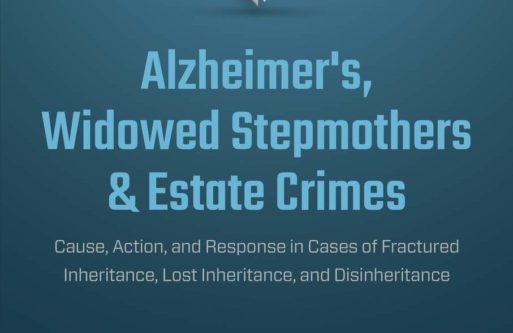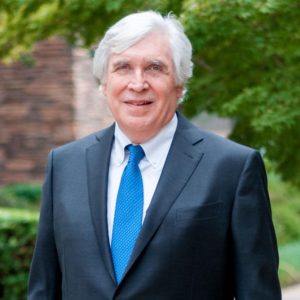
Michael Hackard is a California-based attorney who specializes in estates and trusts litigation. About one year ago, we reviewed his first book, “Wolf at the Door,” an eye-opening and sometimes heartbreaking account of the way America’s elderly are subjected to various forms of financial abuse. Now, Mr. Hackard has written a follow up: “Alzheimer’s, Widowed Stepmothers & Estate Crimes.” And despite the somewhat daunting title, it’s an easy-to-understand and informative overview of the ways in which various bad actors — some of them strangers, many of them family members — take advantage of our most vulnerable elderly to the detriment of all concerned.
As the title implies, Hackard’s book focuses heavily on estate crimes — instances in which nefarious people use undue influence against an elderly person who, many times, is cognitively impaired. In simple, straightforward language, he explains the issues disinherited relatives face in dealing with these kinds of issues. He also writes extensively about “fractured inheritances” — cases in which no crime can be proven, but wherein complex family dynamics and long-held animosities led to the disinheritance of one or more heirs. And while he offers some remedies, he is also very open about the fact that proving wrongdoing and retrieving lost inheritances can be very expensive and very hard.
Real Life Examples
Hackard gives us lots of real-life examples of stolen and misappropriated inheritances, many of which do not rise to the level of actual crimes. In many cases, they involved blended families and multiple marriages — instances in which a second, third or even fourth wife (often much younger than her elderly spouse) suddenly becomes the sole beneficiary of her husband’s substantial estate. In these cases, disinherited children are typically (and rightfully) concerned and upset. But, Hackard warns us, proving wrongdoing in cases involving stepmothers is far from an easy task, especially if the husband isn’t cognitively impaired.
One example Hackard provides to illustrate this point is that of the multi-millionaire founder of Johnson & Johnson, Robert Wood Johnson. Robert Johnson had been married three times by the time he died of cancer at the age of 87 in 1983, leaving behind a $400 million estate. He had six children from his first two marriages when he married his third wife, Barbar Piasecka, in 1971. Piasecka was 42 years younger than Johnson when they wed. None of his children attended the wedding, which provides pretty convincing evidence about how they felt about the union at the time.

Michael Hackard has over 40 years
experience as an estate attorney
Credit: Hackard Law via Yelp.com
After Johnson died, his children learned that Johnson had changed his will — naming their stepmother as sole beneficiary — less than a year before his death. Almost immediately, the children, all adults who were wealthy in their own right, set forth a legal challenge to prove that Piasecka unduly influenced Mr. Johnson. They claimed (although had no proof) that Johnson was cognitively impaired when he changed his will.
Millions and millions of dollars in attorney’s fees and many years later, the family settled the matter and the adult children got some of what they felt they deserved. (Piasecka-Johnson kept $300 million.) But the issue of whether Johnson’s third wife had inappropriately influenced a cognitively impaired old man was never resolved.
A Litany of Bad Behavior
In “Alzheimer’s, Widowed Stepmothers & Estate Crimes” Michael Hackard takes us through an extensive array of situations in which people who thought they were entitled to an inheritance found themselves out in the cold. And while the bad-actors in each case are different — a widow who hides a legitimate will, an ineffective or incompetent trustee, a thief who raids a safe deposit box, an unscrupulous, substance-abusing daughter or son — his advice is remarkably consistent and, in most cases, rather discouraging. In fact, the overarching message I took from this book was that even the best-laid estate plans can and often do fall apart. And when that happens, the heirs need to balance the financial and human cost of litigation with the potential for recovery.
Hackard’s book is a good tutorial for anyone in line for a substantial inheritance. His advice is applicable mostly in California but is also generic enough to provide a basic understanding of the kinds of issues any disinherited heir may face. It also serves as a very good reminder that the best-written documents can’t replace human dialogue and open communication. And that the best time to resolve inheritance issues is before they start.

 “Alzheimer’s, Widowed Stepmothers & Estate Crimes” by Michael Hackard, Esq.
“Alzheimer’s, Widowed Stepmothers & Estate Crimes” by Michael Hackard, Esq.


 John Mulaney’s “Funeral Planning” on Netflix: No Real Plan
John Mulaney’s “Funeral Planning” on Netflix: No Real Plan

 Composting Bodies Is Now Legal in a Dozen States
Composting Bodies Is Now Legal in a Dozen States














